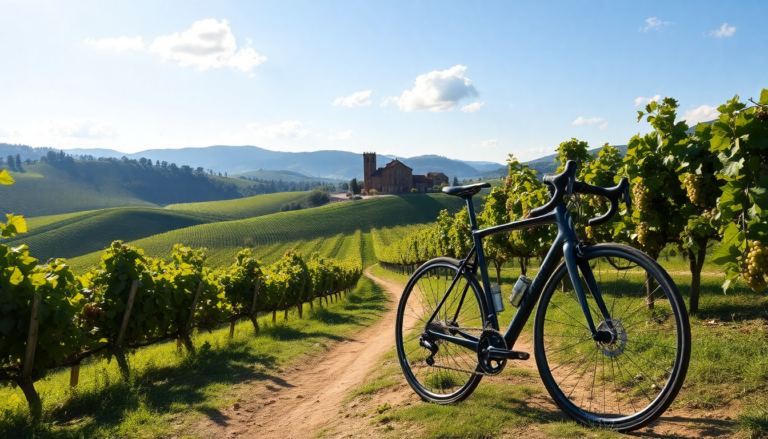Argomenti trattati
The Bar to Bar cycling route invites travelers to embrace the beauty of the Langhe region at a leisurely pace. This circular path connects the charming villages of Barbaresco and Barolo, showcasing a landscape rich in history and culture. Spanning 124 kilometers, the route is designed for those who appreciate the art of slow travel, offering not only breathtaking views but also a glimpse into the local winemaking tradition.
Exploring the route
Connecting two precious gems of Piedmont, Barbaresco and Barolo, this route extends beyond just wine. It encompasses a journey through picturesque panoramas and historic towns, captivating the hearts of cycling enthusiasts and slow travel aficionados alike. The Bar to Bar trail is fully marked and can be navigated in both directions. Various options allow cyclists to tailor their adventures to personal preferences, ensuring that every twist and turn of the path reveals something unique. Importantly, there is no single correct way to tackle this route; it is all about moving at one’s own pace.
The stages of the journey
The itinerary consists of seven stages, starting from Barbaresco and winding through the stunning landscapes of Langhe. The first leg leads to Alba, following the Tanaro River, then ascending towards the Barolo hills through delightful villages such as Roddi, Verduno, and La Morra, known for its sweeping views. The final destination of this stage is Barolo, a favorite among visitors for its exquisite wine production.
For those seeking a more challenging experience, a longer variant also departs from Barbaresco, encompassing additional stops like Neive and Treiso, reaching the Alta Langa and including remarkable places such as Bossolasco and Monforte, ultimately returning to Barolo.
Delight in local treasures
Each stage of the Bar to Bar route is a small journey in itself. Alba, famed for its medieval towers and white truffles, serves as the starting point before venturing into the Barbaresco area. The ascent is gentle yet rewarding, revealing vineyards arranged like lace and forests filled with enticing scents. Historically rich sites tell stories of partisans, such as the ‘Republic of Alba’ narrated by local author Fenoglio.
As cyclists navigate through Altavilla and the Barbaresco lands, they descend into a tranquil oasis where truffles thrive undisturbed. This journey leads to Neive, a gem among the ‘Most Beautiful Villages in Italy,’ rich in noble residences and home to the famous grappa poet, Romano Levi.
Transitioning landscapes
The second stage marks a transition, where hazelnut groves and steep cliffs replace the familiar vineyards of Barbaresco. The Rocca dei Sette Fratelli captivates with its legend and geological formations that narrate millennia of history. The terrain becomes more rugged and authentic, revealing fortified farmhouses and ancient shrines, accompanied by a profound silence that speaks volumes.
The ride continues into the Alta Langa, where hazelnuts reign supreme. Cyclists traverse ancient salt paths, passing forgotten monasteries and landscapes that seem to have emerged from a storybook. The village of Castino surprises with its inverted parish church and remnants of medieval glory, creating opportunities to breathe in the history along the way.
Rich cultural experiences
As the journey unfolds, cyclists encounter stunning ridges and trails within the Belbo Springs Reserve, with Fenoglio’s spirit lingering in every wall, street, and crossroad bearing evocative names. After a breathtaking descent, the route leads to Roddino, where the Alta Langa gradually merges into the Barolo territory. Here, nature and culture beautifully intersect.
Entering the realm of wine mythology, the names of legendary places arise: Serralunga, Castiglione Falletto, and Monforte d’Alba. Pedaling through vineyards, each cru reveals its unique soul, with Serralunga Castle standing guard like a medieval sentinel. In Monforte, the journey culminates in a climb through vineyards and history, arriving at the Saracca and the Horzowsky Auditorium, home to one of Italy’s finest jazz festivals. Even heresy left its mark here, evident in the names of the streets.
A feast for the senses
The landscape of the Langhe is nothing short of postcard-perfect: endless vineyards, timeless villages, and tales of kings and marquises. Barolo welcomes travelers with its castle and the Wine Museum, while La Morra offers breathtaking views of a green sea composed of Nebbiolo grapes. Every village along the way beckons visitors to pause, savor, and inhale the ambiance.
As cyclists descend from Verduno toward the Tanaro River, the towers of Roero shimmer on the horizon. Passing through Roddi, a diversion to Pollenzo is recommended, where the University of Gastronomic Sciences preserves the memory of Pollentia, a Roman town and crossroads of cultures.
Ultimately, the route returns to Alba, the vibrant heart of the Langhe. A final stroll through the center allows for a toast to the journey, with the assurance that each stop has left an indelible mark.
The Bar to Bar route is more than just a cycling path; it is a celebration of slowness, an invitation to explore the region at one’s own rhythm. The journey becomes as significant as the destination, encouraging cyclists to immerse themselves in every corner and view. This circular trail can be divided into multiple days to cater to every traveler’s needs, making it a versatile choice for cycling adventures.
Recognized at the Cycling Tourism Awards, the Bar to Bar has received a special mention from the press for its unique circular itinerary that narrates the UNESCO World Heritage hills. Spanning 124 kilometers and encompassing seven stages, it stands as a true symbol of slow tourism.

